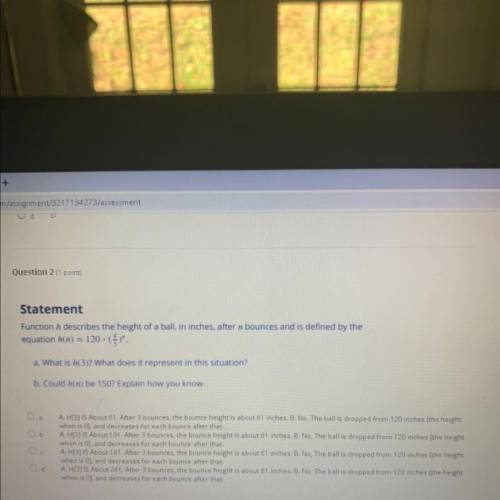
Mathematics, 21.10.2020 20:01 renelopez79318
Statement
Function h describes the height of a ball, in inches, after n bounces and is defined by the
equation h(n) = 120. ()".
a. What is h(3)? What does it represent in this situation?
b. Could h(n) be 150? Explain how you know.
Oь
Ос
A. H(3) IS About 61. After 3 bounces, the bounce height is about 61 inches. B. No, The ballis dropped from 120 inches (the height
when is 0), and decreases for each bounce after that.
A. H(3) IS About 101. After 3 bounces, the bounce height is about 61 inches. B. No, The ball is dropped from 120 inches (the height
when is 0), and decreases for each bounce after that.
A. H(B) IS About 161. After 3 bounces, the bounce height is about 61 inches. B. No, The ball is dropped from 120 inches (the height
when is 0), and decreases for each bounce after that.
A. H(B) IS About 261. After 3 bounces, the bounce height is about 61 inches. B. No, The ball is dropped from 120 inches (the height
when is 0), and decreases for each bounce after that.


Answers: 1
Another question on Mathematics

Mathematics, 21.06.2019 20:10
Select the correct answer what is the most direct use of a compass in geometric constructions? a. to draw congruent angles b. to draw arcs of a given size c. to draw perpendicular lines d. to draw straight lines reset next next
Answers: 2

Mathematics, 21.06.2019 20:20
Aline passes through (1,-5) and(-3,7) write an equation for the line in point slope form rewrite the equation in slope intercept form
Answers: 1

Mathematics, 21.06.2019 21:00
Askateboard ramp is in the shape of a right triangle what is the height of the ramp
Answers: 3

Mathematics, 22.06.2019 00:00
I've been working on this for a few days and i just don't understand, it's due in a few hours. you.the direction of a vector is defined as the angle of the vector in relation to a horizontal line. as a standard, this angle is measured counterclockwise from the positive x-axis. the direction or angle of v in the diagram is α.part a: how can you use trigonometric ratios to calculate the direction α of a general vector v = < x, y> similar to the diagram? part bsuppose that vector v lies in quadrant ii, quadrant iii, or quadrant iv. how can you use trigonometric ratios to calculate the direction (i.e., angle) of the vector in each of these quadrants with respect to the positive x-axis? the angle between the vector and the positive x-axis will be greater than 90 degrees in each case.part cnow try a numerical problem. what is the direction of the vector w = < -1, 6 > ?
Answers: 1
You know the right answer?
Statement
Function h describes the height of a ball, in inches, after n bounces and is defined by t...
Questions


Mathematics, 14.12.2021 20:20

Mathematics, 14.12.2021 20:20


English, 14.12.2021 20:20



Mathematics, 14.12.2021 20:20


History, 14.12.2021 20:20


Mathematics, 14.12.2021 20:20


Biology, 14.12.2021 20:20

Chemistry, 14.12.2021 20:20

Biology, 14.12.2021 20:20

Mathematics, 14.12.2021 20:20

English, 14.12.2021 20:20


Chemistry, 14.12.2021 20:20



